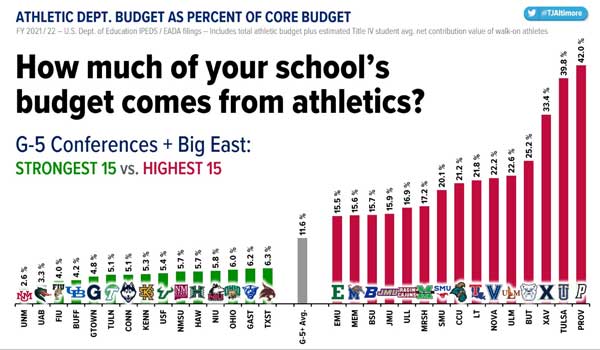| |
Part One: The Case For Camelot

In a social media post following his arrival at Georgetown, head coach Ed Cooley remarked, "I am excited to get to know each and every one of you - from the students including Hoya Blue, our donors including the Hoya Hoop Club, all of our alumni, and the fans in and around the DMV! Let's get to work!"
Easier said than done. Decades of institutional indifference have taken its toll on the fan experience, and there's a lot of work to do before the debut of the Hoyas this fall. As the old saying goes, you never get a second chance to make a first impression... and the 2023-24 Hoyas need a first impression.
In March, we wrote, "The task before Ed Cooley is not only to win, but to be a builder, a man that will listen, learn, and lead Georgetown to a new era that may be uncomfortable to some, unfamiliar to others, but ultimately well overdue. More than anything, he must be given the keys to open doors and make change. The old ways no longer suffice."
As Cooley approaches his first 90 days at Georgetown, his leadership team is in place, some form of a collective is in place, whether or not GU chooses to call it as such, and a patchwork roster for his inaugural season is now on campus. He's also learned, as he might admit, that looking behind the curtain of men's basketball at Georgetown University was a little unusual, even for those in its own profession who knew that things were always done a little differently on the Hilltop than anywhere else, but didn't realize how much different it was.
Inside the doors of 2nd Healy and the Thompson Center, he's made his case. Now, he needs to take the case to those of us outside it.
A coach doesn't have to do this, of course. Adrian (Red) Autry doesn't need to introduce himself at Syracuse, having been an alumnus and an assistant coach for a dozen years. Rick Pitino doesn't needs to explain why a men's basketball team is important for St. John's, a program that hasn't seen a Friday night game at the Big East tournament since Craig Esherick's first full season as Georgetown's coach. So why does Ed Cooley need to tell anyone why basketball is important at Georgetown?
Three reasons are apparent; one is not, but no less valuable.
First, it's been a while. The fall of the House of Thompson wasn't simply a consequence of Patrick Ewing. It's been a slow but, in hindsight, a perceptible descent from the 2007 Final Four to the past two seasons. The names of days gone by remain fresh: Davidson, Ohio, VCU, Florida Gulf Coast. John Thompson III won seven NCAA post-season games in his first four seasons as head coach and two his final nine. Patrick Ewing was given ample time to turn the ship around, and didn't. Excepting the four game run in the 2021 Big East tournament, Ewing's three year record from Feb. 15, 2020 to the end of this season stood at a sobering 22-70, one more defeat than GU lost in the entire decade of the 1980s.
With those years has come an erosion of the under-30 fan base, and let's be frank, an erosion of confidence of Georgetown University as an athletic brand. An entire 10 years of Georgetown alumni have few if any positive memories of what basketball used to be like at the University; this, for a program that hasn't been nationally ranked in eight years and which is 2-18 versus ranked opponents at Capital One Arena over the past seven seasons. Such are not the precious stones that loyalty is built upon. Georgetown must reintroduce itself to a younger fan base which is no longer invested in the program: some may return, some may never return, but it must try.
Second, why basketball? For the spend, Georgetown could be a great soccer school, a great lacrosse school. A few million dollars could make track a world-class engagement at Georgetown, and it certainly would elevate football beyond the awkward state it is in now.
Fifty, forty or even twenty five years ago, basketball at Georgetown was a clear and convincing story: an engagement which elevated the brand of Georgetown University, provided an opportunity to build out other sports at the school, and served to connect GU with a mostly black city to whom the school had ignored for decades. Basketball, not football or lacrosse, was that ship and John Thompson was its captain.
Cooley, his team, and his University need to start reminding people, both inside and outside it, that basketball is something Georgetown can do very, very well in. Even if it's 2023 and this is not the Washington of days gone by, this program is eminently capable of attracting, recruiting, educating and graduating (yes, let's say that again) local men whose lives will be better for the four years they invested in a Georgetown education, and the University will be better for having admitted them. It's not enough to say that Georgetown plays basketball because that's where the money is; on its face, this is a recipe for failure. Let's remind people that basketball is positioned for greatness at Georgetown and their support (social, financial or philanthropic) is an investment in success. As the old song put it, "we did it before and we can do it again."
Third, the one percent factor.
For reasons previously explained (see the bottom half of this article for details), Georgetown spends a lot of money on men's basketball: a total of 30 percent of the budget for a 30-sport athletic program supports just one team. That amount is just under one percent of the University operating budget. However you slice it, that's a significant annual investment, and one which simply doesn't exist in most academic departments. Where Georgetown under-spends on programs to which success is an achievement but not an expectation, that should never be the case for men's basketball.
Ed Cooley is not the highest paid employee at Georgetown University because he's a parent, or that he's friendly to recruits, but that he will excel. The case must be made that a nationally prominent budget for him and his team is an investment in that excellence, not merely to show up on a Wednesday in March at Madison Square Garden and be home by nightfall. That investment, in people, process, and community, must be a sign of strength and a building block of a sustained excellence last seen at Georgetown many years ago.
In a longer view of athletes and tuition relative to budgets, Georgetown's athletic impact on its overall budget is far smaller than Big East schools with less diversified programs.
 But to whatever lens we view it, Georgetown maintains a strong institutional commitment which must be clear and with expectations set. These commitments strengthen a core message about the future of Georgetown Basketball: to engage, to empower, and to excel. Now comes the work.
But to whatever lens we view it, Georgetown maintains a strong institutional commitment which must be clear and with expectations set. These commitments strengthen a core message about the future of Georgetown Basketball: to engage, to empower, and to excel. Now comes the work.
To borrow a fateful quote from Cooley's predecessor, what happened last season can never happen on his watch.

This week's commentary series focuses on four areas to reimagine the Georgetown basketball experience:
- Opening Doors: There are a lot of bridges to be rebuilt. From high school coaches to newspaper columnists, students to social media, the old ways no longer apply in 2023. In an era where Georgetown has gone from a "who's who" of basketball programs to a "who's that", or worse, a "who cares" program, a new story needs to be told. This is the year to do it.
- The Constituents: A cascade of Venn diagram circles contain the active constituencies of this program: students, staff, alumni, donors, the DMV region, and the extant support base beyond the Capital Beltway. Different targets, but the same core message, and the potential for growth is apparent.
- The Main Event: Coach Cooley has remarked on more than one occasion about the need for a home court atmosphere, and it goes without saying that Georgetown is seriously deficient in this. Attendance at Capital One Arena has dropped by 50 percent in the past ten seasons, and little has changed inside its walls. To get 4100 students in the building by November is a tall order, and that's only part of the equation. What can be done, by whom, and by when?
- The Two Way Street: The velocity to which Georgetown can affect rapid change in the trajectory of the men's basketball program is now directly tied to fundraising channels. But which channels, how, and when? The one way approach often seen between Hoya basketball and its donor base is about to change in a seismic way.
In a pair of recent Zoom calls, Cooley talked about "rebuilding Camelot" with the Georgetown program. At first, this seems a stretch.
A history major at Stonehill, Ed Cooley wasn't talking about a Monty Python routine or even the halcyon tales of the Kennedy administration, which is about as relevant to today's incoming students as World War I was to students of the 1980s. He may be referring to Camelot as parents do when first gazing upon that university on the hill, a place of legend and lore.
It's important to know the difference between the two: legend is a present tense, lore is a past tense. That university on the hill has more than its share of basketball lore, but legends - new ones - will be ready for the making. Cooley's mission, as we'll discuss further this week, is built on the need for getting everyone on board - not to rely on lore, but to be energized by the challenge of something new.
The tools are there, and now it's about time. Making the case this season sets Georgetown on a course of new adventures, or as was sung in the musical of the same name:
In short, there's simply not
A more congenial spot
For happily-ever-aftering than here
In Camelot."
--JR
|



 But to whatever lens we view it, Georgetown maintains a strong institutional commitment which must be clear and with expectations set. These commitments strengthen a core message about the future of Georgetown Basketball: to engage, to empower, and to excel. Now comes the work.
But to whatever lens we view it, Georgetown maintains a strong institutional commitment which must be clear and with expectations set. These commitments strengthen a core message about the future of Georgetown Basketball: to engage, to empower, and to excel. Now comes the work.